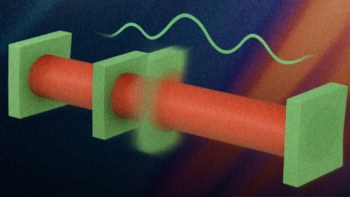Taken from the 25th anniversary issue of Physics World, this article examines one of the five biggest unanswered questions in physics as selected by the magazine’s editors
Scientists and philosophers have been debating the nature of time for centuries, and despite some progress, Adam Frank believes that this is one mystery that seems likely to endure

The problem of time is one of the oldest conundrums we have, and the fact that our lives are finite makes it the most intimate and personally pressing “deep” mystery about reality. Physicists from Newton onward have, in some cases, directly addressed issues concerning time that were once the domain of philosophers. But the science of physics – charged as it is with embracing the whole of physical reality – has added its own perspectives (and paradoxes) to questions about time, its structure and its fundamental reality. The result is that there is no single problem of time in our science. Instead, there are many interwoven problems that may require more than one conceptual revolution to resolve.
The poles of debate over time in western thinking were laid down by two Greek philosophers, Parmenides and Heraclitus, around the 5th century BC. The tradition established by Parmenides claimed that time, as a measure of change, is an illusion, and that reality, at its most fundamental level, is timeless and eternal. In contrast, Heraclitus and his followers claimed that nothing exists beyond time and that change – relentless in its advance – is the only fixed feature of reality. Debate about the fundamental nature of time in physics takes place within the shadow of these ancient distinctions. Even today, you will find physicists at both the Parmenidean and Heraclitan ends of the spectrum – and pretty much everywhere in-between.
One early proponent of a “middle way” between Parmenides and Heraclitus was Isaac Newton. The development of Newtonian mechanics established the modern paradigm for scientific inquiry and in doing so split the difference, in some sense, between the two ancient views on time. While the differential equations of Newton’s dynamics treat time as a parameter that flows at a constant rate everywhere in the universe, these equations represent laws that are themselves eternal and exist outside of time. After Newton, the prospect of discovering additional timeless “laws of Nature” became a siren call of inspiration for all of science, marking its special place among the modes of human inquiry.
Newton’s own laws were, of course, found to be valid only in the limits that speeds are less than that of light and length scales are larger than those associated with quantization. But however much the rise of relativity and quantum mechanics changed our views of Newton’s universe, their development did not alter his essential idea that at least one aspect of reality – the laws of physics – exists beyond time.
Within our search for timeless laws, physics has brought us to a number of essential realizations (and open questions) about temporality. One of the most obvious and still unresolved of these questions is the famous “arrow of time”. All established fundamental laws governing the dynamics of particles – the most elementary of physical objects – are time-reversible. Nothing in Newton’s equations of point-mass dynamics or Schrödinger’s equations for the wave function can tell us which direction the hands on the clock should turn. The macroscopic world, however, brooks no such indecision. Scrambling eggs and stirring cream into coffee make it clear that an arrow of time from past to future is an essential component of reality.
Back to the beginning
As a physical principle, questions concerning the “arrow of time” appear in the language of dynamical (differential) equations that govern physical processes. As such, it is not something the Greeks would have recognized. It was only with the advance of thermodynamics (and, later, statistical mechanics) that this dilemma was resolved, after a fashion, by averaging over the micro-states associated with each macro-state of many particles. Thus a new quantity associated with large systems – entropy – entered the lexicon as a stand-in for time in the macroscopic world.
Thinking in terms of entropy, however, only pushes the problem of time’s arrow backward. Once the entropy (in other words, disorder) is maximized, a system reaches equilibrium and each moment will look, essentially, like the next – bar the occasional fluctuation. Thus physicists must become cosmologists to ask why we live in a universe where entropy was initially low enough to allow evolution, and therefore change, to continue. The discovery that our universe began in a Big Bang meant that this cosmological arrow of time had to be pushed back to a question of cosmic initial conditions. But as Roger Penrose, Sean Carroll and other theorists have argued, low-entropy initial conditions within the classic Big Bang scenario are extremely unlikely.
Research at the frontiers of physics embraces an astonishing range of possible natures of time, which demonstrates both how far we’ve come and how far we still have to go
Questions about the universe’s initial conditions bring us to the search for that most fundamental of fundamental theories: quantum gravity. Efforts to quantize the classical space–time of general relativity are discussed elsewhere in this issue (see pp42–43), but one important consequence of such research has been to push theorists to new frontiers in our understanding of time. For example, consider the troubling fact that when you cast Schrödinger’s equation in a form appropriate to the space–time of general relativity, you end up with an equation in which time does not appear. This time-free expression is known as the Wheeler–DeWitt equation, and it presents us with a set of “cosmological” quantum states for the universe without any way of evolving between those states.
Does the Wheeler–DeWitt equation mean that Parmenides was right, and time is merely an illusion? The question is far from settled, but many of those working on quantum gravity argue that the time and space we are familiar with cannot be fundamental. Instead, they insist that time and space must be built from something more essential – something with quite different properties from our usual notions of locality and temporal progression. In its modern setting, the question “Is time real?” is phrased in terms of time emerging from some deeper set of principles.
For other researchers, however, the paths taken in the search for quantum gravity pose troubling questions. Andreas Albrecht, for example, has noted that moving from the Wheeler–DeWitt equations to the time-bound world we experience introduces a new puzzle, which he terms the “clock ambiguity”. As Albrecht has demonstrated, there is no straightforward way to choose which part of the new quantum-compatible theory should act as a clock, and which should be called “space”. Making such a choice, in effect, de-unifies space–time, and Albrecht has found that different, arbitrary, choices for what plays the role of a clock can lead to entirely different sets of physical laws.
A plea for time’s reality
An even more strident criticism of current approaches comes from Lee Smolin, who has argued that the centuries-old emphasis on timeless laws represents a conceptual stumbling block. In Smolin’s view, the drive for eternal laws to describe reality as a whole has backed fundamental physics into a corner where it is forced to consider “potential” realities, as is the case for multiverse theories and their infinite and possibly unobservable other universes, rather than the one we experience. Smolin also takes a bold step into the Heraclitan domain by arguing that time is the bedrock of reality and cannot be considered emergent. According to this argument, even physical laws must be bound within time and can, therefore, change.
Research at the frontiers of physics embraces an astonishing range of possible natures of time, which demonstrates both how far we’ve come and how far we still have to go. Time has proven to be a remarkably durable mystery in physics. We should expect it to remain so, just as we should expect it to continue provoking our most creative scientific responses – at least for the time being.



